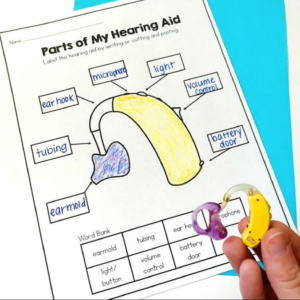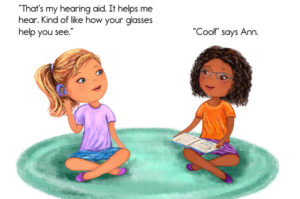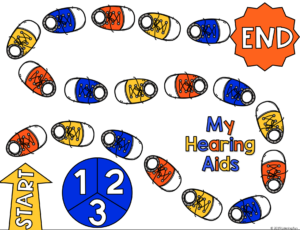Overview:
With the advancement of technology over the previous decades, the success of hearing assistive devices has skyrocketed, along the with numbers of hearing impaired people using them. Overall, hearing assistive technology comprises of numerous types of hearing aids (over the ear, in ear, bone anchored) and cochlear implants, all of which vary in brands, models, and intended use. A few other devices have been used historically, but hearing aids (HAs) and cochlear implants (CIs) remain the most popular practices. While the use of hearing technology varies in levels of success in Deaf persons, this is largely due to the fact that each person is unique in their source and severity of hearing loss, type of device(s) used, goals of the individual, age at which intervention began, and the measures taken to enrich auditory stimulation and language development once devices are fitted.
Hearing Aids (HAs)

Hearing aids are used for people with mild to profound hearing loss at almost any age. While both HAs and CIs treat sensorineural hearing loss, they do so employing different mechanisms. Hearing aids assist those with damaged auditory nerves (whether genetic or traumatic) by amplifying the acoustic signals and allowing the damaged cells to “hear.” They are not amplification devices, and they are usually customized to the extent and frequency of hearing loss of the individual in order to allow for optimal sound experience.
HAs are extremely beneficial in that they’re versatile and can be adapted to the needs of the person, which makes them ideal for young children whose hearing loss may change over time. Types of hearing aids include behind the ear, in the ear, in the canal, and more, which really only vary in the placement of the hearing aid. These cause no risks to the individual, and the only associated disadvantage to the use of hearing aids is a matter of comfort. All hearing aids contain the same components and perform the same task, regardless of the model.
Cochlear Implants (CIs)
Cochlear Implantation is a much more serious approach to hearing loss and involves long term benefits… and consequences. While hearing aids administer sound directly to the damaged areas of the ear, cochlear implants differ in that they altogether bypass the inner ear and instead stimulate the auditory nerve itself, which in turn sends the electronic signals to the processing center of the brain. This can only be done through a surgically implanted device into the brain that receives the electronic signals from its external counterpart. The external component consists of a behind the ear processor with a microphone taking up acoustic signals from the environment and the magnetically adhered transmitter sending messages to the internal electrode array. Whenever this transmitter is disattached from the internal receiver, hearing sensation ceases.
As implantation requires outpatient surgery and is a permanent fixture, CIs involve risks that are not associated with hearing aids. Aside from the potential complications of any surgery involving general anesthesia, cochlear implantation can most notably result in nerve damage and the loss of any residual hearing one might have. The adjustment period to implants can be anywhere from 6 months to beyond a year, and the implantation is a life long commitment. Cochlear implants are only used in the situation that hearing aids cannot or will no longer assist in hearing.

Hearing Assistive Technology and Language Development
Just as there is an optimal time frame for exposure to language, there is also an optimal period for exposure to auditory stimulation. When congenitally deaf children receive access to sound within this time frame, they can build the audiological basis required for typical language acquisition, resulting in the developmental milestones such as babbling or speaking their first word. Because they lacked the initial exposure, some delays may occur, but overall language progression will ensue in the same order as typically developing children. Children who receive hearing aids or cochlear implants (compared to those who don’t) have been documented with improvements in the following:
- Age-appropriate speech perception
- Speed of word recognition
- Speech intelligibility
- Phonological awareness¹
- Grammar skills
- Vocabulary development
- Overall rate of expressive and receptive language development
Note that these effects are apparent in both children who sign or speak (or both). Language improvements occur in the child’s primary language, so no matter the classroom approach, hearing assistive technology can promote language
Hearing Technology in Education
Because adjustment to use of hearing assistive technology involves a frustrating and complex, educators must be understanding and be a part of the process. In a Deaf Education preschool classroom, teachers often approach technology in the following ways:
- Daily listening checks
- Goal setting²
- Feedback from both instructor and student³
- Helping children understand their Deafness – and self-esteem⁴
- Management and care of hearing devices
If the student is in a hearing environment, a specialist or school speech pathologist will typically provide this support.
A large aspect of hearing technology in classrooms is the use of FM receiver systems, which stream audio from a source directly to the sound processors of students’ hearing aids or cochlear implants. Not only does this allow for the best sound experience in noisy environments, it assists in students’ improving speech perception by allowing easy and clear access to auditory input. This helps children focus on meaningful sound that they should be using to develop linguistically.
Sample Activity: Self-Advocacy Series by Listening Fun
Students who use assistive technology need to learn to stand up for themselves and their needs both in educational and social environments. The Self-Advocacy series helps children in discussing how and why their devices work, and how being different isn’t a bad thing.
“My Hearing Aids” tells the story of student Julia on her first day of class. Her classmates notice her hearing aids, and Julia is able to face her nervousness and explain.

Discussion questions such as “Why do you think Julia was nervous?” and “Why did people ask her about her hearing aids?” helps students in understanding their identity as Deaf and the devices that may accompany that identity. And of course, reading comprehension plays a role as well.
The following “My Hearing Aids Game” builds on this understanding, but also assists in general knowledge of one’s own hearing aids and their expected maintenance, while putting it in a fun context.


Notes:
1 – Phonological Awareness; Phonological awareness is the sensitivity to the sounds that comprise a given language. After receiving hearing aids or cochlear implants, deaf children are exposed to phonemes in a way they never have been before. In optimal scenarios, this allows for the distinguishing of individual sounds that make the oral therapy approach to language possible. In listening to themselves, friends, or other auditory stimuli, these children are employing their phonological awareness skills to grasp the meaningful differences in sound.
2 – Goal Setting; Goal setting is an important aspect of improving strategic thinking as well as motivation. With help from instructors, the setting of explicit overall goals and subgoals helps learners to mark their progress. This is commonly used after cochlear implantation in the oral therapy approach. Instructors and the deaf student make goals together about what they may wish to distinguish or produce, whether it be individual sounds or sentences. For example, the Pirate’s booty activity focused on a goal of being able to produce an “a” sound. This is only possible through the exposure to sound resulting from hearing technology.
3 – Feedback; The process of receiving input. Feedback from an instructor is important in that it affects a student’s learning process and motivation. This feedback should include meaningful, directive information about how students can improve in the future and what was done well. In the use of hearing technology, Deaf educators often use FM systems to help students hear effectively – both the instructor and themself. Amplification of student sound production attempts using an FM microphone and receiver helps the student to make sense of therapist’s feedback and to make their own feedback and corrections.
4 – Self-Esteem; Self-esteem involves self-worth, or how individuals view and evaluate themselves emotionally. Deaf children in hearing schools can often feel anxious about their use of cochlear implants or hearing aids because they identify these are markers of being different. If classmates respond negatively to these devices, negative self-evaluations become a part of the individual and may alter their negative self esteem over time. On the other hand, accepting and welcoming friends like Ann in the story can help deaf students embrace their differences and feel more confident.
